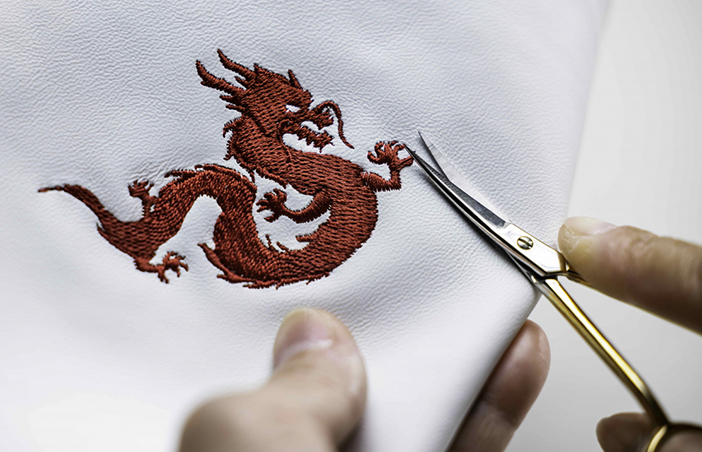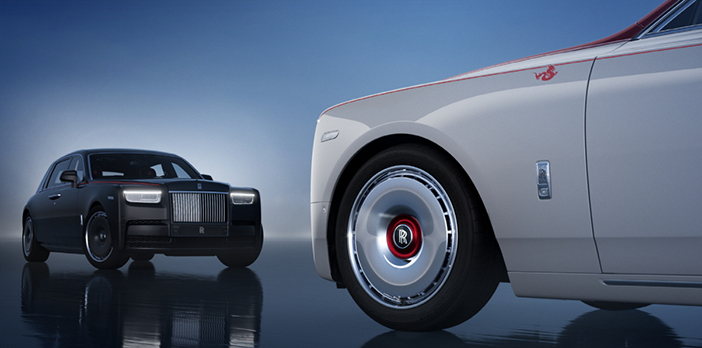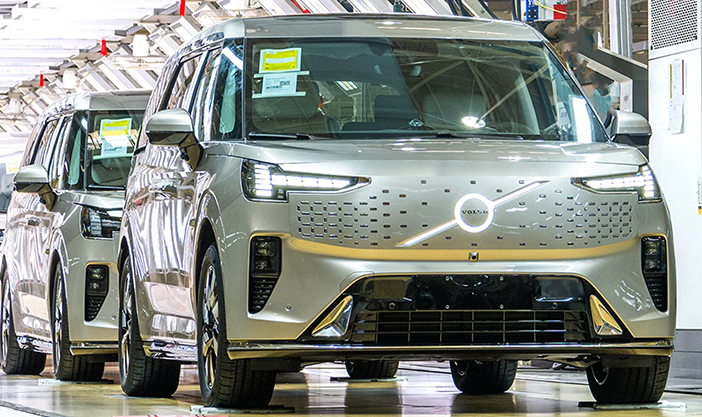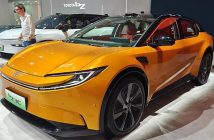+++ With a focus on French luxury, the DS brand is aimed squarely at the likes of Audi, BMW and Mercedes in the premium car market. Its latest offering could really give the Germans something to worry about given that it’ll be positioned as the flagship DS and equipped with the best tech the Stellantis group has to offer. DS has pointed towards a future all-electric, coupe-SUV range-topper before when it revealed the Aero Sport Lounge concept back in 2020. While the new production model will be toned down visually from that concept, it’ll still sport the intricate DS design language and a bold shape. From this spy picture we can clearly see that it’ll have a coupe-SUV bodystyle, not too dissimilar from that of the Citroën ë-C4. Despite the camouflage we can spot the thin LED headlights and not much of a grille to speak of; just a small opening low in the front bumper. The side profile of the DS shows how rakish the rear is and there are quite thin rear lights either side of a central brake light integrated into the boot lid. The funky wheel design looks to have been taken directly from the new Peugeot E-3008, but that should be no surprise given that the flagship DS is expected to sit on the same STLA Medium platform as its Peugeot sibling. The same 73 kWh battery from the E-3008 could be used for the DS, with range potentially rising over the Peugeot’s 520 km maximum due to the DS’ slipperier coupe shape. The platform will cater for a 98 kWh battery and given the model’s position as the flagship DS, it’s possible it will only be offered with this unit for a range of around 700 km and a greater premium appeal. Power will come from a 210 hp single-motor or a 320 hp dual-motor set up. While the STLA Medium architecture can allow for internal-combustion engines, DS announced in 2021 that it will only launch all-electric new cars from 2024 onwards. This new flagship will be fully unveiled in Q3 of 2024 and pricing will sit near to that of the current range-topping DS, the DS 9, at around €69.000 euro in the Netherlands. +++
+++ HONDA ’s profit rose 3.5% in the October-December quarter from a year earlier on the back of solid demand in the U.S. and Europe and a recovery in its home market, the company said Thursday. Tokyo-based Honda’s profit in the last quarter was 253.3 billion yen. Quarterly sales jumped 21% to 5.39 trillion yen. A favorable exchange rate helped amplify Honda’s overseas profits in yen terms and is expected to continue through the rest of the fiscal year, which ends in March. The dollar has been trading at about 148 Japanese yen, up from about 140 yen last year. All the automakers have been hurt by shortages of computer chips and other parts, partly due to disruptions in manufacturing because of the coronavirus pandemic. The latest results show Honda has mostly but not yet fully recovered to pre-pandemic levels in some locations. Honda said it remained committed to “initiatives toward electrification”, pointing to the global electric vehicle concept models shown at the Consumer Electronics Show in Las Vegas, such as the Saloon and Space Hub. Japanese automakers including Honda have lagged in the global push toward pure EVs, partly because of their strength in other green models such as hybrids and fuel cells. Over the first 9 months of the fiscal year, Honda sold 3.1 million vehicles, up from 2.7 million vehicles the previous year, with sales especially strong in the U.S. A decline in Honda’s vehicle sales in Thailand and Indonesia was offset by rising sales in China. For the full fiscal year through March, Honda is projecting a 960 billion yen profit, up from an earlier forecast for a 930 billion yen, and surpassing the 651 billion yen earned the year before. +++
+++ NISSAN ’s profit sank in October-December to about half of what it earned the year before, the automaker said Thursday, though it stuck to its earlier earnings forecasts. Nissan, based in the port city of Yokohama, reported its profit was 29 billion yen in the last quarter, down from 50.6 billion yen a year earlier. Quarterly sales jumped nearly 10% to 3.1 trillion yen for the maker of the Leaf electric car, Infiniti luxury models and Z sportscars. Market conditions were especially difficult in China, Stephen Ma, Nissan’s chief financial officer, told reporters. The Chinese auto market remains intensely competitive amid a price war between manufacturers, dominated by locals like BYD, with its strong EV offerings. Nissan’s vehicle sales in China plunged 35% in April-December from the previous year. Nissan sales rose about 30% in the U.S. from a year earlier, helping to offset the China woes. For the first 9 months of the fiscal year that ends in March, Nissan’s global sales rose 22% to 9.17 trillion yen. Nissan kept unchanged its annual projection for a 390 billion yen profit on 13 trillion yen in sales. Nissan expects to sell 3.55 million vehicles globally for the year through March, down from an earlier projection of 3.7 million vehicles. That’s still better than the 3.3 million vehicles Nissan sold the year before. By region, Nissan expects vehicle sales to grow in the U.S., Japan and Europe, but not in China. +++
+++ ROLLS-ROYCE is commemorating the year 2024 ahead of the Lunar New Year with limited Year of the Dragon Bespoke Commissions, featuring four distinctively designed vehicles, exactly 12 years after its first dragon-themed Phantom in 2012, which sold out in China within 2 months of release.

Introduced last Friday, the 2024 exclusive collection includes 3 extended versions of the Phantom and 1 Cullinan, each adorned with design elements inspired by the dragon, a symbol of prosperity and good fortune in Chinese culture. Each vehicle in the series showcases a distinct color scheme, enhanced by a bespoke Phoenix Red coachline featuring a right-facing dragon motif, representing the east and the rising sun. The Cullinan is finished in cherry red, a color symbolic in Chinese culture, signifying joy and luck. It is complemented by gray exterior accents and wheel centers bearing the Rolls-Royce emblem in red. The 2 Phantom models in the collection display 2-tone color themes. One model features a striking combination of a silver body and a red roof, while the second Phantom opts for a more subdued black exterior with red accents that trace the car’s profile and accentuate the wheels. Inside, the dragon theme continues with a hand-painted red dragon stretching across the dashboard. This theme extends to the detailing, including Phoenix Red stitching on the headrests and rear Piano Black picnic tables. The tables also feature a stainless steel inlay of the Chinese zodiac calendar, with the dragon symbol taking prominence. This intricate stitching process alone takes an estimated 20 hours of labor, the company said. The dragon motif even extends to the Starlight Headliner, a signature feature of Rolls-Royce, which in this series features a constellation of lights arranged to depict the silhouette of a dragon. This creates a semi-virtual experience for the passengers as if cruising under a celestial dragon. China is by far the biggest market in the region and the second-biggest market for Rolls-Royce, accounting for 25 percent of its global sales in 2022 with approximately 1.500 vehicles sold. +++

+++ 2 decades after London began moves to clamp down on SUV cars, Parisians voted on whether to squeeze the gas-guzzlers out of town by tripling their parking fees. The proposal by Paris’s Socialist mayor Anne Hidalgo was the most radical by a big city in the fight against the big cars, blamed for driving up emissions, being a menace to pedestrians and generally taking up too much space. The number of SUVs on the roads have shot up nearly sevenfold since 2010, to about 330 million worldwide. They consume around 20 percent more fuel than a typical medium-sized car, the International Energy Agency said in a 2023 report, and emitted nearly one billion tonnes of carbon dioxide (CO2) in 2022, around twice Brazil’s total emissions. The backlash against SUVs and monster pickups dates back to the 2000s, when the suburban rich began migrating en masse from sedans to king-of-the-road behemoths previously used for rough terrain. Dubbed “stock exchange tractors” in Norway or “suburban assault vehicles” in Britain the car-trucks became much-maligned status symbols. A key breakthrough in the bid to regulate emissions in big cities came in 2003 when London’s left-wing mayor Ken Livingstone introduced a congestion charge for vehicles entering the city centre. A year later he took aim specifically at SUVs, criticizing those who used them to drive children to school as “complete idiots” and saying the vehicles should be banned from the school run. Inspired by London, Paris first floated a clampdown on the most polluting vehicles. But the project was shelved in 2005 after fierce opposition from motoring associations. In 2007, authorities in Dublin picked up the issue and proposed to double parking charges for SUVs. They were also forced to back down after public outcry. Eco-vigilantes in countries including France and Sweden stepped into the fray with campaigns of mass SUV tyre deflations between 2005 and 2007. In the past few years, they have grown more radical, with a British group called The Tyre Extinguishers drilling holes in the tires of dozens of SUVs. With the Earth’s warming reaching critical levels and SUVs blamed for increasing pedestrian deaths in the United States, legislators are back on the anti-SUV warpath. Last year, Washington DC ramped up its registration fees for extra-large SUVs, requiring owners of vehicles weighing over 2.700 kilograms) to pay 460 euro annually, almost 7 times the cost for a typical sedan. New York is also mulling an increase in its weight-based registration fees. In Germany, the crusading Green mayor of the southern city of Tübingen, which aims to become climate neutral by 2030, increased parking rates for SUVs by 600 percent in 2022, declaring them unnecessary for city living. But another Germany city, Freiburg, had to row back on a rise in parking fees for longer vehicles after it was thrown out by the Federal Administrative Court. Meanwhile, London has been made into an “ultra-low emission zone”, with cars that do not meet its emissions targets paying €14.50 a day to enter the capital. Parking charges in London and in other councils, including Bath and North East Somerset, have also introduced emissions-based parking fees. +++
+++ Behind TOYOTA ’s record earnings announced last Tuesday are its relentless efforts to make its vehicles reliable and operations leaner. A series of data fraud scandals at the auto group have put part of its success formula at risk of collapse. Data rigging in vehicle certification tests within the Toyota group reflects a shift in the group’s strategy and a lack of close communication between the parent and group companies, analysts say. Toyota reported an all-time high net profit of 3.95 trillion yen for the April-December period and expects the bottom line to reach a record high for the full year, while it is forecast to become the first Japanese company to post annual sales of more than 40 trillion yen. Still, its upbeat earnings will do little to address longer-term quality control challenges for the group, analysts say. Toyota’s affiliate Toyota Industries Corp said recently that third-party investigations found engine data had been falsified for years, while it was discovered that safety data had been manipulated for decades at the parent company’s small-car specialist Daihatsu. The misconduct follows similar cases of cheating on emission and fuel efficiency data at Hino, Toyota’s truck-manufacturing subsidiary, revealed in 2022. In the auto industry, vehicles are expected to become more connected, autonomous, shared and electric, or CASE. Toyota aims to operate more effectively in cooperation with its subsidiaries and affiliates to respond promptly to rapid changes in customer demand. The automaker is putting more focus on developing environmental and safety technologies while asking its sister companies to play a greater role in the conventional vehicle business. “Toyota is the biggest business partner for its group companies. They might have been under more pressure” than the parent company had thought, Seiji Sugiura, a senior analyst at the Tokai Tokyo Research Institute, said. Toyota executive vice president Hiroki Nakajima said at a press conference in December that his company had been unaware Daihatsu engineers had been under increasing pressure to speed up the development of new models for Toyota. The wholly owned unit had to work on product development “under an extremely tight and rigid schedule,” according to a third-party probe set up by Daihatsu. Hino and Toyota Industries were also obliged to make engines that would be more fuel-efficient and improve driving performance in a limited period of time. The 3 companies found it hard to meet Toyota’s requests but orders from the world’s largest carmaker were too large to decline for their entire businesses, analysts say. Toyota acknowledges that the power balance between itself and its group of suppliers has been delicate. The hierarchical relationship has likely hindered open discussions between them, analysts say. Some group companies “might find it difficult to express their opinions freely to Toyota, as in most cases Toyota makes the orders”, Toyota chairman Akio Toyoda said at a press conference last week. “There should have been more communication between Toyota and its group companies”, said Masahiro Fukuda, a senior researcher at auto research firm Fourin. The key is to create a sense of “psychological safety” so that everyone can have open and candid discussions. A shortage of engineers also added pressure on the 3 companies in their efforts to respond promptly to requests from Toyota, analysts say. “The scandals’ biggest cause is that the group firms lacked the necessary resources to match the amount of work they had to do”, Fukuda said. Toyota once found itself overstretching as its annual global production approached an unprecedented level of 10 million vehicles. It remains a top priority for the automaker to ensure it has enough talent and resources to pursue both higher volumes and reliable vehicles sustainably. Toyota group companies are also feeling the pinch in keeping pace with the highest volumes produced by the automaker. “From the suppliers’ point of view, they can’t say they won’t be able to meet the production schedule as Toyota is their biggest customer”, Tokai Tokyo’s Sugiura said. +++
+++ The Chinese automotive market experienced a notable fluctuation, with new car sales totaling 2.03 million units in January 2024, according to data released by the China Passenger Car Association (CPCA). This figure represents a year-on-year increase of 57.4% and a month-on-month decrease of 13.9%. The decline from December 2023 to January 2024 can be attributed to automakers’ reduced discounting activities, which had been aggressively pursued in the final month of 2023 to meet annual sales targets. The New Energy Vehicle (NEV) sector, encompassing both electric vehicles (EVs) and plug-in hybrid electric vehicles (PHEVs), continued to exhibit stable growth amidst the market’s recovery, contributing to 33.8% of the total vehicle sales in January 2024. EV sales stood at 396,000 units, while PHEV sales reached 291,000 units. It’s worth noting that January 2023 and February 2024 traditionally mark the Chinese New Year, which results in lower sales due to factory and retail store closures. This seasonal change tends to affect sales figures, making performance in January 2024 stronger than January 2023. As a result, the overall sales volume of the market this month increased by more than 50% year-on-year, and the top 10 sales brands are all growing. VOLKSWAGEN took the lead with an impressive sale of 209.476 units in December 2023, achieving a year-on-year growth of 41.5% and claiming a market share of 10.29%. This made it the only brand to exceed a 10% market share for the month, overtaking BYD, which had consistently held the number-1 spot for 11 consecutive months. BYD, not far behind, ranked second with sales amounting to 191.122 units, marking a 43.4% increase from the previous year and securing a 9.39% market share. Toyota followed in third place, with sales reaching 141.689 units, up by 35.1% year-on-year, resulting in a 6.96% market share. Changan and Wuling completed the top-5, with sales of 130.408 and 129.638 units, respectively. BYD’s dominance in the NEV sector remains unchallenged, leading the EV and PHEV markets with significant shares. The brand held a 26% market share in China’s EV market and an even more dominant 34% share in the PHEV category for the month. In the pure electric vehicle segment, BYD continued its leadership with sales of 98.423 units, capturing a 26.18% market share. Tesla, with sales of 39.881 units, ranked second, achieving a 10.61% market share in the EV category. The top-selling models in the Chinese market for the month were Changan’s CS75Plus, leading with 40.496 units, followed by Volkswagen’s Lavida with 32.419 units and BYD’s Song Plus closely behind with 32.267 units sold. +++
+++ The Chinese Geely Group started the mass production of VOLVO ’s first minivan (MPV), the EM90. It is a rebadge of the Zeekr 009 multi-purpose vehicle. So far, the Volvo EM90 will be available only in China. It will start deliveries in March this year. The Volvo EM90 was launched in China on November 12, 2023. It stands on the Geely’s SEA platform that underpins Polestar 4, Lotus Eletre and Emeya (it is slightly upgraded and called EPA), Jiyue 01, Smart #1, Smart #3 and every Zeekr model. The EM90 dimensions are 5.206 x 2.024 x 1.859 mm with a wheelbase of 3.205 mm. It has 6 seats with a 2+2+2 layout and 21 Bowers & Wilkins speakers. The powertrain of the Volvo EM90 comprises a 200-kW electric motor on the rear axle powered by a 116 kWh battery for 738 km of CLTC range. In China, the starting price of the Volvo EM90 is 818,000 yuan (more than 160.000 euro in the Netherlands). Basically, the Volvo EM90 is a rebadged Zeekr 009 MPV with a polished interior and an adjusted exterior. However, the Zeekr’s minivan offers 4WD for 400 kW and a starting price of about 100.000 euro. So, the EM90 gives customers less for a much higher price. On February 2, the Volvo EM90 rolled off the production line, marking the start of the mass production. The Swedish automaker shared photos from the assembly line and stated that the Volvo EM90 accelerates the comprehensive electrification transformation of the brand. The Geely’s Hangzhou Bay plant in China manufactures the Volvo EM90 alongside Zeekr 009, Zeekr 001, Zeekr 001 FR, Jiyue 01 and Polestar 4. This plant’s peak capacity reaches 300.000 per year. Last year, the Zeekr 001 electric liftback made 90% of its daily production rate. Now, the model line of this factory has become way more diverse. The Volvo EM90 is based on a Chinese car and is being assembled at a Chinese factory. So, its Swedish heritage is highly questionable. Anyway, Volvo plans to start the deliveries of the Volvo EM90 in March this year. There is no information about its overseas intentions. +++




